What Is a Power Bank Used For? -I’ll be honest — my phone has this strange talent for dying right when I need it most. Whether I’m waiting for a ride, checking flight updates, or trying to capture a perfect sunset photo, that low-battery warning always shows up at the worst time.
That’s when a power bank becomes a real-life hero. But what exactly is it used for — and why do so many people (including me) never leave home without one anymore?
Let’s find out.
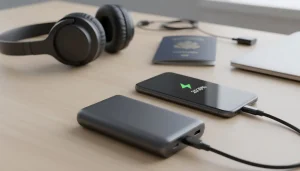
What You’ll Learn in This Post
Here’s a quick peek at what I’ll cover:
- What a power bank actually is
- Different ways people use it (beyond just charging phones)
- Features that matter when choosing one
- Travel rules for carrying one on a plane
- Smart tips for getting the most life out of your portable charger
- A few product recommendations (from my other blog posts, you can check out)
Understanding What a Power Bank Is
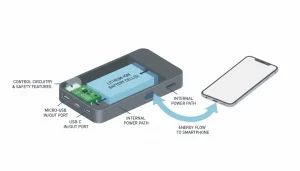
A power bank — also called a portable charger or backup battery — is a small device that stores electrical energy for later use. In simple terms, it’s like a spare fuel tank for your electronics.
Instead of searching for a wall socket when your phone battery dies, you just plug your device into the power bank and charge on the go.
It works through a rechargeable lithium-ion or lithium-polymer battery inside, which transfers energy to your devices via USB or USB-C cables.
Why I Always Carry One
I used to think carrying a charger was enough. But then reality hit during a 6-hour bus ride — no outlets, no phone signal, and a dead battery. Since then, I have never traveled without my portable charger.
Here’s why:
- It keeps my phone alive when I’m shooting photos or videos.
- It powers my wireless earbuds and smartwatch.
- It lets me use navigation without worrying about draining the battery halfway.
- And honestly, it gives me peace of mind — I know I’ll stay connected anytime.
The Real Uses of a Power Bank
Sure, charging a smartphone is the main reason people buy one, but there’s more to it. Here are the most common — and some surprisingly creative — uses.
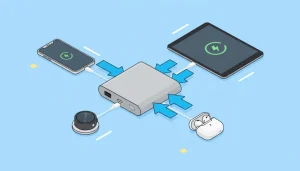
1. Charging Phones and Tablets
This one’s obvious. A portable charger can bring your phone back to life several times, depending on its capacity. For tablets, it’s especially handy when traveling or studying outdoors.
If you’re curious about travel-friendly options, I’ve already written a detailed guide — check out my blog on Best Power Bank for International Travel.
2. Keeping Laptops Alive
Modern power banks come with higher wattage outputs (like 65W or more), meaning they can even charge laptops — especially models with USB-C charging ports.
For example, I use mine to top up my MacBook Air while working in cafés or airports. It’s not just about convenience — it’s freedom from wall plugs.
3. Charging Wearables and Accessories
Headphones, smartwatches, and fitness trackers drain quickly if you use them daily. A compact portable charger keeps these smaller gadgets powered without needing multiple adapters.
I even carry one when hiking, just in case my GPS watch needs a quick boost mid-trail.
4. Powering Cameras and Drones
If you’re into photography or travel vlogging, a backup battery is your best friend. DSLR cameras, GoPros, and even drones can be charged using USB-compatible power sources.
When I shoot outdoor content, I plug my camera directly into my portable charger between shots. That extra boost has saved my projects more than once.
5. Emergency Backup During Power Cuts
Let’s face it — electricity isn’t always reliable, especially in remote areas. A fully charged backup battery keeps phones and flashlights working during unexpected blackouts.
For professionals working remotely, this can be a real lifesaver.
6. Perfect for Long Travel Days
Whether you’re backpacking through Asia or sitting on a long-haul flight, charging options are often limited. I can’t count how many times my charger saved me during airport delays or overnight trains.
If you fly often, my post Can I Bring a 10000mAh Power Bank on a Plane? goes through the flight-safety rules for these gadgets.
7. Gaming Consoles and Portable Devices
Nintendo Switch, Steam Deck, or even Bluetooth speakers — they all benefit from an external charger. For gaming marathons, I carry a high-capacity version that supports fast output.
8. Charging Multiple Devices at Once
Some power banks feature two or more USB ports, letting you charge your phone and earbuds simultaneously. It’s also great for sharing — I’ve saved friends from dead-battery doom more times than I can count.
Different Types of Power Banks
You’ll notice that not all portable chargers are built the same. Let me break it down quickly.
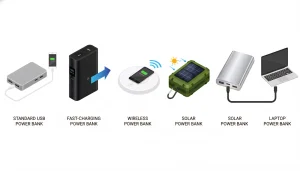
1. Standard USB Power Banks
These are the basic ones — good for phones, earbuds, and small electronics. Simple plug-and-play devices that fit easily in a pocket or bag.
2. Fast-Charging Power Banks
If you’re always on the move, choose one that supports Quick Charge or Power Delivery (PD). They refill your device battery much faster.
3. Wireless Power Banks
Forget cables. Place your phone on top of the device, and it charges wirelessly (as long as your phone supports Qi wireless charging). Perfect for messy desk haters like me.
4. Solar Power Banks
Ideal for outdoor enthusiasts or camping trips. These come with built-in solar panels to recharge themselves under sunlight — eco-friendly and practical.
5. Laptop Power Banks
These beasts have high-capacity batteries and support 45W to 100W output. Great for laptops, tablets, and even portable fans or cameras.
Understanding Capacity (mAh)
The capacity of a power bank is measured in milliamp-hours (mAh) — it basically tells you how much energy it can store.
- 5,000 mAh → small, great for one phone charge
- 10,000 mAh → standard size for daily use
- 20,000 mAh → heavy-duty option for multiple devices
- 30,000+ mAh → ideal for travel, laptops, or long outdoor use
If you’re unsure which one fits your lifestyle, you can check out my detailed guide on Portable Power Bank for Phone for recommendations.
Features to Look For
Not all backup batteries are created equal. Here are a few things I always check before buying one:
- Output power: Look for at least 18W for fast-charging phones.
- Number of ports: Two or more is ideal.
- Weight and size: Lightweight options are easier to carry — see my blog on Ultra Lightweight Power Bank for top picks.
- Pass-through charging: Lets you charge your phone and the power bank at the same time.
- Safety features: Overcharge and short-circuit protection are must-haves.
Travel Safety and Airline Rules 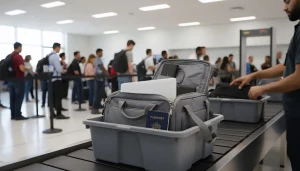
If you’re planning to bring your power bank on a plane, here’s what you need to know:
- Always carry it in your hand luggage, not checked baggage.
- The usual capacity limit is up to 100Wh (roughly 27,000mAh).
- Airlines may allow higher capacities with special approval.
I’ve written an in-depth explanation in How Many mAh Power Bank Allowed in Flight — it clears up all the confusion.
Tips to Extend Its Lifespan
A few small habits can make your portable charger last longer:
- Don’t overcharge it. Once it’s full, unplug it.
- Keep it away from heat. Extreme temperatures damage the battery.
- Recharge it every few months, even if unused — this prevents cell degradation.
- Use original cables. Cheap ones can cause slower charging or even damage.
- Store it safely. Avoid tossing it in your bag with sharp objects.
Environmental Impact
Batteries don’t last forever, but disposal matters. When it’s time to replace your old charger, drop it off at an electronic recycling center. Some brands even have trade-in programs where you can recycle responsibly.
Common Mistakes People Make
- Buying cheap knockoffs with no safety certification
- Ignoring the mAh rating
- Forgetting to charge the charger itself (yes, I’ve done that too)
- Using mismatched cables that reduce performance
A bit of research can save both your money and your devices.
Choosing the Right One for You
When picking a portable charger, I think about three main things:
- Usage: Do I need it for daily charging or travel?
- Capacity: How many devices do I plan to charge?
- Portability: Will I carry it in my bag or pocket?
If you travel frequently, check out Best Portable Power Bank for Phone — it’s one of my most detailed buying guides.
Smart Ways I Use My Power Bank
Here are some less obvious but super handy ways I use mine:
- Powering a USB mini fan during summer trips.
- Keeping my Wi-Fi router alive during internet outages.
- Charging my wireless mic while filming videos.
It’s one of those little tools that you don’t realize you rely on — until you forget it once.
A Few of My Favorite Picks
I’ll be honest — I’ve tried quite a few. Here are the ones that impressed me the most:
- Anker PowerCore 10000 PD Redux: Compact, fast, and travel-approved.
- Baseus Blade 100W: A laptop-friendly beast that recharges everything quickly.
- Nimble Champ (Series 2): Eco-conscious and lightweight — my daily go-to.
Power Bank Etiquette (Yes, It’s a Thing)
If you share one with friends or colleagues, always ask first before unplugging their phone. And please — don’t be that person who returns it half-empty. 😅
Final Thoughts
So, what’s a power bank used for? Pretty much everything that keeps your digital life running smoothly. From your phone and laptop to your camera and smartwatch — it’s the modern world’s safety net.
For me, it’s more than just a gadget. It’s freedom. The ability to move, create, and stay connected without hunting for a socket.
If you’re still deciding which one to buy, explore my related posts — I’ve researched so you don’t have to.
FAQs
Can I use my phone while charging it from a power bank?
Yes, you can. It might charge a bit slower, but it’s perfectly safe.
How long do portable chargers last?
Most last between 300–500 charge cycles, roughly 2–3 years depending on usage.
Are all power banks allowed on airplanes?
Only those under 100Wh capacity. Always check airline guidelines before flying.
How many times can a portable charger charge a phone?
It depends on the capacity. A 10,000mAh battery can usually charge a smartphone about two to three times, while a 20,000mAh one can do four or more full charges.
Is it safe to use a power bank every day?
Yes, as long as you’re using a quality one with proper safety certifications. Avoid cheap, unbranded models that might overheat or damage your device.
Can I charge my phone and the power bank at the same time?
Some models support pass-through charging, which lets you do both simultaneously. However, it’s best to check your model’s specs before trying this regularly.
Does charging overnight damage a power bank?
Leaving it plugged in once in a while isn’t a big deal, but doing it often can shorten its lifespan. Unplug it when it’s fully charged.
Can I carry multiple power banks on a plane?
Yes, as long as they’re all within the airline’s watt-hour (Wh) limit—usually under 100Wh each—and kept in your carry-on, not checked luggage.
Can power banks damage my phone battery?
Only if they’re low quality or incompatible. A certified one with proper voltage regulation keeps your phone completely safe.
Do fast-charging models really make a difference?
Absolutely. If your phone supports fast charging, a PD or QC-compatible model can get you from 0% to 60% in roughly half an hour.
Can I use a power bank to charge other gadgets like cameras or earbuds?
Yes! Most modern ones work perfectly with cameras, Bluetooth speakers, earbuds, and smartwatches through USB or Type-C ports.
How do I dispose of an old or dead power bank?
Never toss it in the trash. Take it to an electronic recycling center or drop-off bin to prevent fire risks and reduce waste.
Liked this post? Check out my other guides on Best Power Bank for International Travel You Can Fly With for more practical advice.